Where: The title that was printed on the bottom of the postcard reads: "A 89 Western Market Hong Kong"
But here's a modern photo of Hong Kong's Western Market.
It shows Western Market stands on flat land, not a steep slope like the one in the main photo, so the postcard printer made a mistake with their title. Instead the postcard shows Sai Ying Pun Market, on Centre Street between Second and Third Streets. The market building is the light-coloured building in the distance on the left side of the road.
When: This was the second generation of Sai Ying Pun Market, replacing the first generation that stood just off to the right of this view. The 'new' market opened in 1932, so this photo was taken after that.
The photo was printed as a postcard, and luckily for us this copy has been mailed, giving us another date.
The message was written on 15 June 1956, so the photo was taken sometime between 1932 and 1956. The clothes people are wearing look to me to be post-war, so I'll guess this photo was taken in the early 1950s. If you can spot anything that confirms that - or points to an earlier date - please leave a comment below*.
Who: Here are closer views of some of the people, and maybe their fashions can help with the photo's date. These two young men stand out with their neatly cut, and very glossy, hair. Their jackets are also very shiny. Were they made from a modern synthetic material? Or silk, perhaps? Or some older waxed or oiled material?
Several women are using a variety of broad-brimmed hats and umbrellas to keep the sun at bay.
The umbrella at bottom left is also keeping the sun off the baby that the lady is carrying on her back. Here are a couple more young children in similar cloth carriers.
These children will be in their seventies now - please let us know* if you recognise them, or even spot yourself!
What: The constant flow of people heading to and from the market make this a good location to have a shop. The shops have their shades down to block the hot, afternoon sunshine, but we can still get a glimpse of what two of the shops in the foreground are selling.
I've made this crop lighter to see what's in the shadows. The man looks to be selling some sort of food in bulk from those large, glass jars at the front of the shop. Can anyone recognise what they'd be?
This is the name of the shop, hanging next to the first floor's laundry that's out drying in the sunshine.
The shop next door is also selling in bulk. We've seen shops like this before, so I think these are barrels of rice.
Each barrel has a narrow sign sticking out from the top, which should confirm what they contain.
In this case the photographer didn't capture all of the vertical signboard with the shop's name, so we're missing the first couple of characters. But I think we can see them over the shop entrance (written right-to-left), so I've pasted them into the crop.
We can't see clearly into the other shops, but there is one more sign at the end of the terrace.
Then up past the market is the last sign I can see on the left side of Centre Street, shown at left-centre in this crop.
It's faint to read but it looks like the first character is "正", the Chinese character for the "Centre" of Centre Street. Across on the right side there is the familiar bat-shaped sign of a pawn shop, and one last vertical sign below it. (If you remember any of these businesses, or have any information about them to share, please let us know in the comments below*.)
The crowds of people have also attracted plenty of hawkers. The group at bottom left are selling from their baskets. I notice their shoulder poles are left attached to the baskets, possibly so they can make a quick escape if they spot any government inspectors approaching.
Across to the right there's what looks to be the most basic form of hawking: no basket in sight, just a couple of handfuls of vegetables laid out on the road. If that is really what we're looking at, this lady must have been going through a very difficult time.
Further right, the last hawker doesn't look too happy about being captured on film. He doesn't want to sell you vegetables to take home, he's hoping you're hungry right now, and will buy the snack he's selling from that wooden bucket on the left.
His bowls have a colourful rooster as their design (seen upside-down here). You'll still see bowls with this design in stores today.
Finally, just above his head is something I'm always on the lookout for. Fastened to the lamppost is a rat bin!
Gwulo photo ID: BF001
Further reading: I explore lots more scenes like this in my series of books, Old Hong Kong Photos and the Tales They Tell. If you've already got the books, photo #1 in Volume 1 introduces rat bins, photo #7 in Volume 2 shows Sai Ying Pun in the early 1900s, and Volume 4 has a sequence of photos, #5 - #12, showing various shoulder poles in use.
Behind the scenes: One of the choices when buying old photos like this one is whether to buy online, or at a live auction. I mostly buy from online sites such as eBay as their prices tend to be lower, but the downside is that I'll only find out the real quality of the photo after I've paid for it and received it.
In the case of this photo, I bought it at an auction here in Hong Kong. I'd been along to the viewing day before the auction, taking my magnifying glass with me. So although the price was higher I knew the photo was a sharp one, and that there was lots of detail to explore.
(*e-mail subscribers, if you'd like to reply, or see other readers' replies, please click to visit the online comments.)
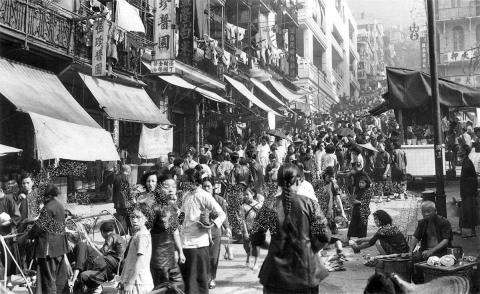

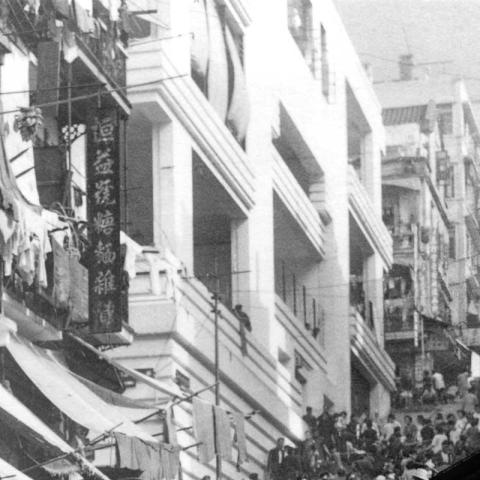

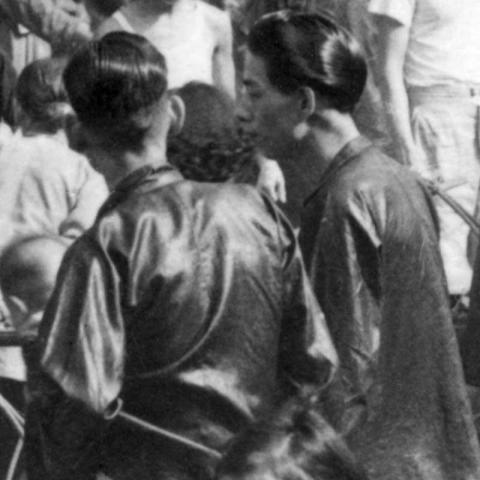
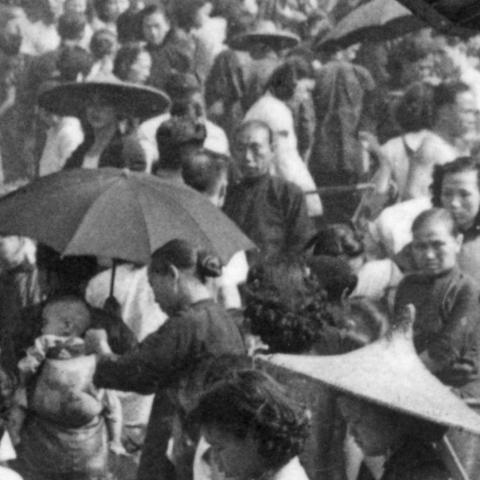
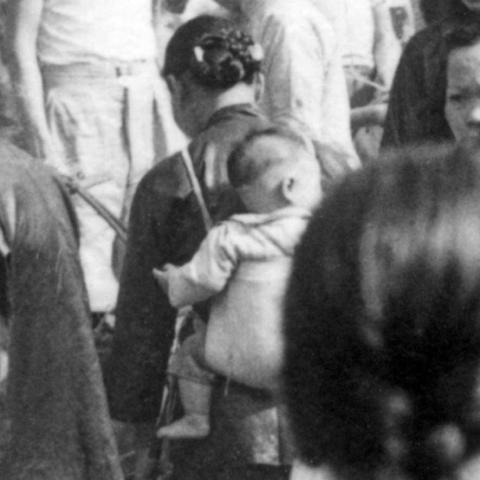

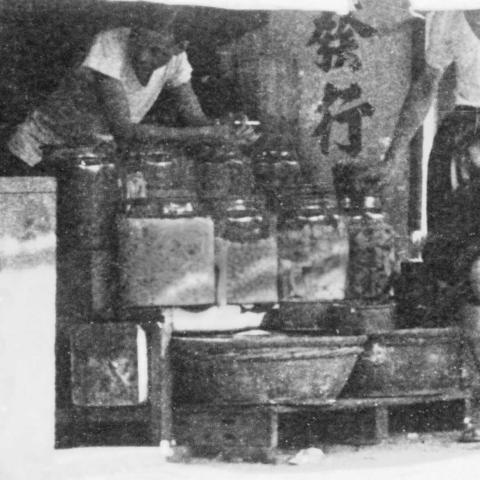

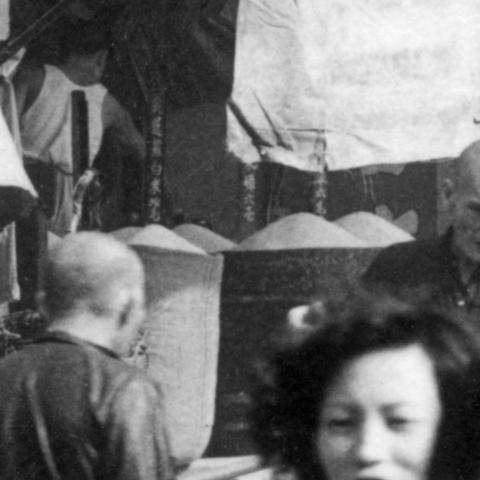



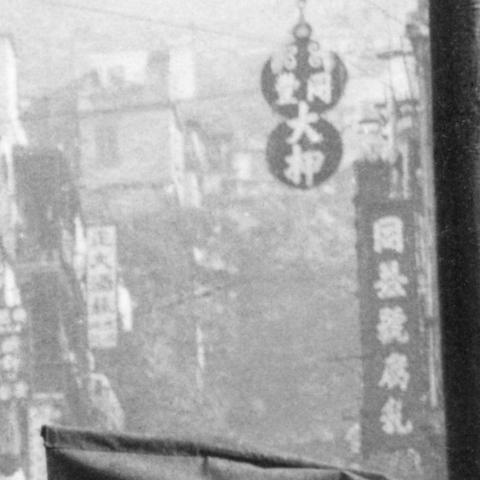
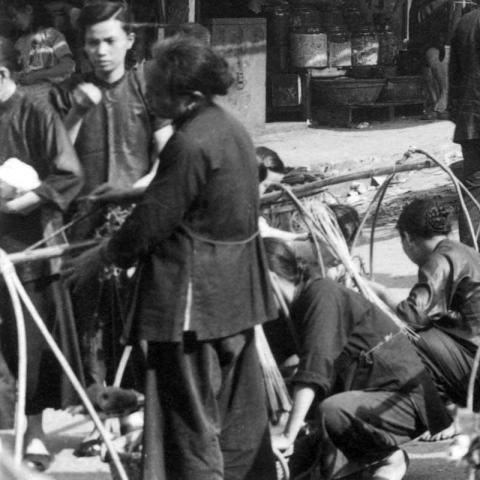


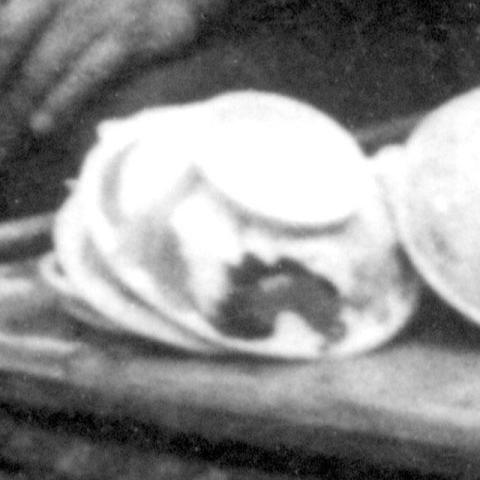
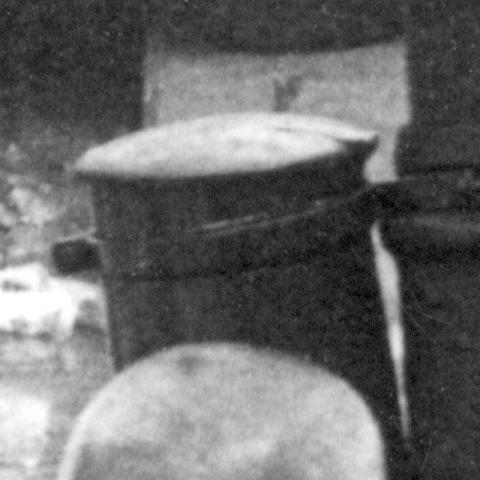
Comments
The shops
Hi David,
Thank you for the lovely photo! I could help give a bit more info about those stores!
- For the guy with large jars, although I am too young to recognise what those are, the shop name suggest it is a sauce making and selling shop (醬園). They usually sell all kinds of Chinese sauce (e.g. soya sauce, shrimp paste, XO sauce, oyster sauce...you name it!)
- You are right! The shop next door is selling rice. The word rice (白米) is written on the narrow signs and included in the name of the shop
- The last one sells sugar(糖), noodles(麵) and other groceries (雜貨)
- I don't think the sign with the word 正 is to indicate the location (i.e. Center street) but more like part of the name of a shop/ restaurant (正文XX, couldn't recognise the characters). Still, in the same photo, we have the sign of a pawn shop (大押) and interesting enough - a shop that specifically sells fragmented bean curd (腐乳)!
Love how this forum help younger generations learn more about the old Hong Kong! A huge thanks to all the contributors!
Cheers,
Angela
Street scene
I think the fabric was called 漆布, basically a cloth material impregnated with a resin to make it somewhat waterproof and more durable.
Those wide-brimmed hats are 蜑家帽, worn by the boat people, not Hakka hats worn by the Hakka people.
Unlike Britain, umbrellas are also used as parasols in HK.
Carrying babies with their hips spread wide open this way is good for the treatment of subluxation of the hip joint.
Those big glass jars at the 恆珍醬園 (Hung Chun Sauce Co.) probably contained salty/sweet preserved fruits such as wah muis, flattened lemons, gingers, olives, etc. They also sold sweet vinegar and soy sauce.
Price tags in rice shop - Siamese rice: $0.75 per catty, Middle: 米碌 (?broken rice) $0.60 per catty, Right: $0.60 per catty.
Rice shop name: 萬益隆(永記) 白米
The white sign on L: 正大酒樓 (Really Big Restaurant), Pawn shop:同豐大押, Fermented Beancurd shop: 同益號腐乳
The old man was likely selling silken bean curd dessert in that wooden bucket.
Shiny black silk fabric
I remember well-heeled eldery Chinese men and women ( & frequently with an almost complete set of gold teeth) wearing this shiny black silk attire. My undertanding is that this was "Canton Silk" (it went by a variety of names) which was mud-treated. The silk was churned and then "buried" in a special mud for a certain period of time, allowing bacteria and chemicals to produce this shiny satin effect. There was a South China Morning Post Sunday Magazine article several decades ago explaining how this was done.
Centre St, SYP
Congratulations, David, on a very interesting and entertaining analysis of this old photo.Great detective work. Makes me want to study my own collection more closely the way you do. Very helpful commrnts from other subscribers as well. Broadens my outlook considerably. Thanks!
香雲紗 - A type of treated silk fabric
https://zh.wikipedia.org/wiki/%E9%A6%99%E4%BA%91%E7%BA%B1
Just acknowledging
Memories and nostalgia!
Thanks David and everyone.
Look at the vicinity of Centre Market from opposite direction
Just to provide further information, I have found this photo on Pinterest.
https://ar.pinterest.com/pin/7599893094071419/
While Centre Market is not seen in the photo, it was shot from the opposite direction or at least from a different angle. The first two characters of the rice shop "萬益隆永記白米" can also be seen on the right.
I might be wrong, but I notice that the distance of the signboard "恒益號糖麵雜貨" from the building appears to be different (further out) from that in your photo. Any signboard control by the government? I wonder.
Opposite view
I think 恒益號糖麵雜貨 was the same sign. But the other sign may not be the same one as in the other photo, as this one has dark characters on a white background, and the other one has lighter characters on a dark background, but then again these might be the 2 sides of the same sign using different BGs.
Vertical & Horizontal shop signs did not match
The shop just to the right of the rice store - The vertical signs on the pillars looked like 恆X酒X (wine store), but the horizontal sign on top seemed to be 恆X白米 (rice store).
Centre Street
I had a message by email that the lady with the vegetables that I described as a poor hawker may instead have been laying vegetables out in the sun to dry, as a way of preserving them for future use in cooking. When I showed this photo to my wife, that was also her comment.
@tkjho I agree the hats aren't the Hakka style, but I'm not sure they're the style worn by the boat people either? I think their hats have a turned-down brim like the one shown at https://g.co/arts/ksK1AoprSALNGBf99
Thanks to everyone for their translations and explanations of what we're looking at.
Regards, David
Re: Original Photo Postcard
Just for reference, the original B/W photo was also available in hand-tinted. The photographer had also taken other views of Centre Street but from different angles on the same day, all with photo designations as A 89 or No. 89. Definitely early 1950s. So far I have noticed postmark dates from 1954 which means the postcard had been printed for sale much earlier.
Veggie lady
I think the lady was in the process of sorting out her veggies and maybe picking off some bad leaves.
It's unlikely that she would lay out the veggies to dry in an open street market when she might have to pack them up and run any minute. Unsually it's done near home by laying them out on top of a mesh or strung up with a string to allow for better ventilation from both sides.
Hats
David,
Thanks for pointing out the hats. I suppose those were generic ones worn by people that work mainly outdoors to shield themselves from the hot sun.
http://1.bp.blogspot.com/-SpBFFUa4fUc/UzWZkl7aSeI/AAAAAAAAtDg/sFVJh_DFkfc/s1600/Woman+guides+her+bullock-drawn+plough+across+a+harvested+paddy-field,+Hong+Kong,+1946-47.jpg
https://i2.kknews.cc/SIG=1d1es4n/11263/8552737179.jpg